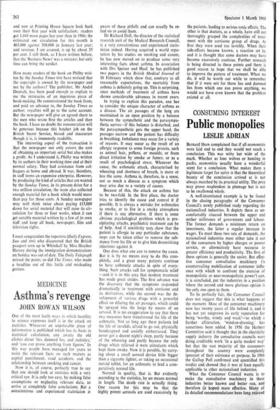Asthma's revenge
MEDICINE JOHN ROWAN WILSON
One of the most facile ways in which hostility to science expresses itself is in the attack on statistics. Whenever an unpalatable piece of information is published which has its basis in statistical calculation, one awaits the old clichés about 'lies, damned lies, and statistics,' and 'you can prove anything from figures.' In this way people have managed for years to resist the relevant facts on such matters as capital punishment, road accidents, and the relationship between smoking and cancer.
Now it is, of course, perfectly true to say that one should look at statistics with a very critical eye. It is only too easy, by making false assumptions or neglecting relevant data, to arrive at completely false conclusions. But a conscientious and experienced statistician is aware of these pitfalls and can usually be re- lied on to avoid them.
Dr Richard Doll, the director of the statistical research unit of the Medical Research Council, is a very conscientious and experienced statis- tician indeed. Having acquired a world repu- tation by his studies on smoking and cancer, he has now moved on to produce some very interesting facts about asthma. In association with Drs Speizer and Heaf, he has published two papers in the British Medical Journal of 10 February which show that, contrary to all reasonable expectations, the mortality from asthma is definitely going up. This is surprising, since methods of treatment of asthma have shown considerable advances in recent years.
In trying to explain this paradox, one has to consider the unique character of asthma as a disease. The air passages of the lung are maintained in an open position by a balance between the sympathetic and the parasympa- thetic nerves—if this balance is disturbed, and the parasympathetic gets the upper hand, the passages narrow and the patient has difficulty in breathing. Imbalance may occur for a variety of reasons. It may occur as the result of an allergic response to some foreign protein, such as animal hair, pollens, or moulds; or from direct irritation by smoke or fumes; or as a result of psychological stress. Whatever the cause, the asthmatic attack, characterised by wheezing and shortness of breath, is more or less the same. Asthma is, therefore, in a sense, not so much a disease as a symptom which may arise due to a variety of causes.
Because of this, the attack on asthma has to be two-fold. In the first place, the doctor tries to identify the cause and control it if possible. It is always a mistake for asthmatics to smoke, or to live in a smoky atmosphere if there is any alternative. If there is some obvious psychological problem which is pre- cipitating attacks, psychiatric treatment can be of help. And if sensitivity tests show that the patient is allergic to any particular substance, steps can be taken either to remove the sub- stance from his life or to give him desensitising injections against it.
One does what one can to remove the cause. But it is by no means easy to do this com- pletely, and a great many patients continue to have asthmatic attacks in spite of every- thing. Such attacks call for symptomatic relief —and it is in this area that modern treatment has made great strides. The first advance was the discovery that the symptoms responded dramatically to treatment with cortisone and its derivatives, while the second was the de- velopment of various drugs with a powerful effect on dilating the air passages, which could be sprayed into the lungs by means of an aerosol. It is no exaggeration to say that these two measures have transformed the life of the asthmatic. Not so long ago these patients led the life of invalids, afraid to go out, physically handicapped and socially embarrassed. They never got a decent night's sleep, partly because of the wheezing and partly because the only drugs which relieved it were stimulants which kept them awake. Now it is possible, by carry- ing about a small aerosol device little bigger than a cigarette lighter, or taking an occasional steroid tablet, for an asthmatic to lead a com- paratively normal life.
Normal in quality, that is. But evidently according to the statistics, by no means normal in length. The death rate is actually rising. One reason for this may be that the highly potent aerosols are used excessively by the patients, leading to serious toxic effects. The other is that doctors, as a whole, have still not thoroughly grasped the complexities of treat- ment with the cortisone group of drugs. At first they were used too lavishly. When their side-effects became known, a reaction set in, and it is thought that some doctors may have become excessively cautious. Further research is being directed to these points and there is good reason to hope that we shall be able to improve the pattern of treatment. When we do, it will be worth our while to remember that if it were not for those lies and damned lies from which one can prove anything, we would not have even known that the problem existed at all.


































 Previous page
Previous page